Strategic Entrepreneurship: Cleaning Service Business Plan Report
VerifiedAdded on 2021/06/15
|8
|1845
|14
Report
AI Summary
This report delves into the strategic entrepreneurship of a cleaning service business designed for the Singaporean market. It outlines various exit strategies, including liquidation, acquisition, management buyout, and IPO, with a focus on liquidation as a primary option for the startup. The operational overview covers labor costs, material expenses, and location considerations within Singapore's economic landscape. The report provides detailed financial information, including fixed and variable costs over three years, along with a summary statement of capital sources and startup expenses. Furthermore, the report addresses employee training methodologies, emphasizing workshops, paired training, checklists, and simulations to enhance service quality. The analysis incorporates relevant references to support the business plan and strategic decisions.
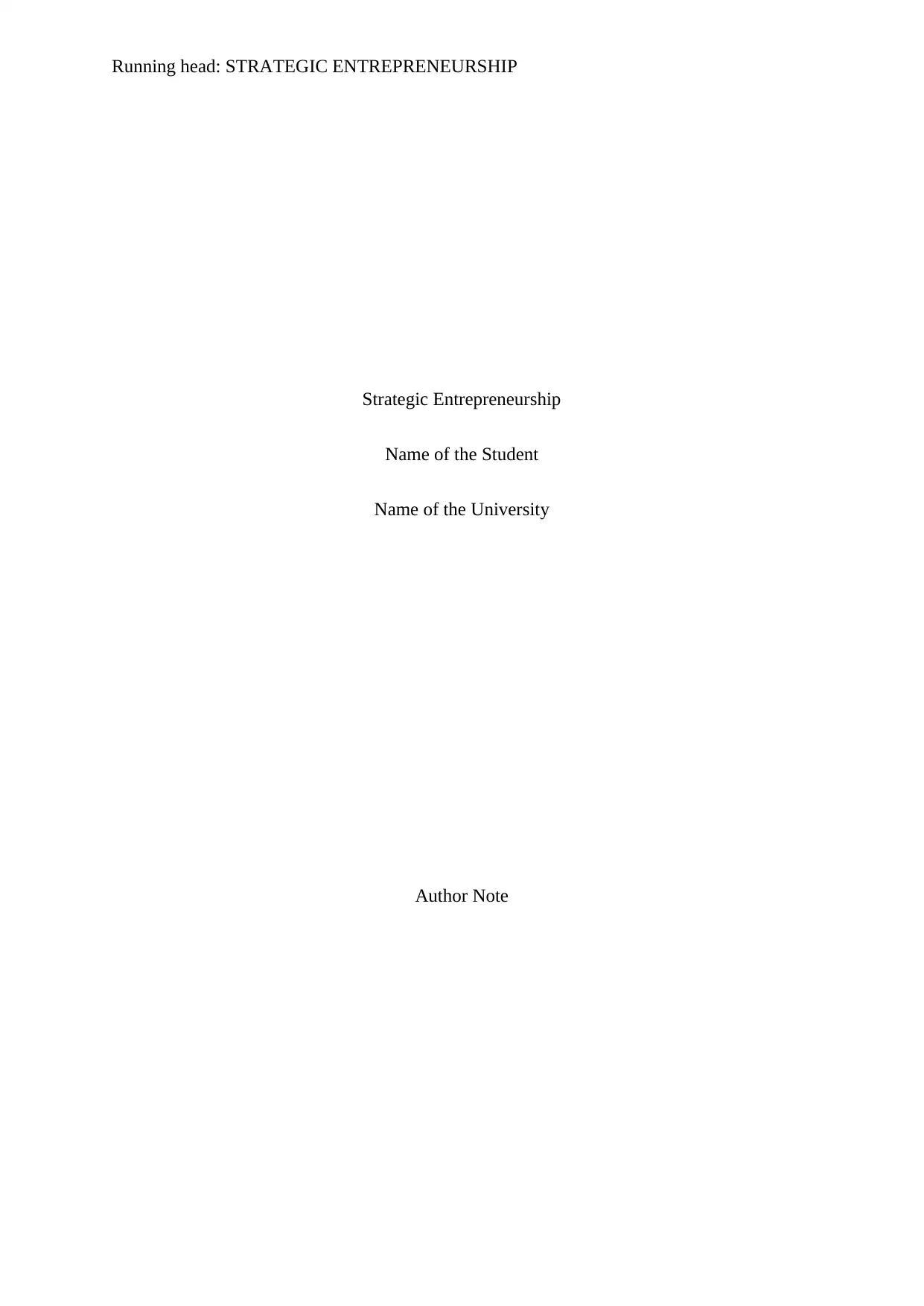
Running head: STRATEGIC ENTREPRENEURSHIP
Strategic Entrepreneurship
Name of the Student
Name of the University
Author Note
Strategic Entrepreneurship
Name of the Student
Name of the University
Author Note
Paraphrase This Document
Need a fresh take? Get an instant paraphrase of this document with our AI Paraphraser
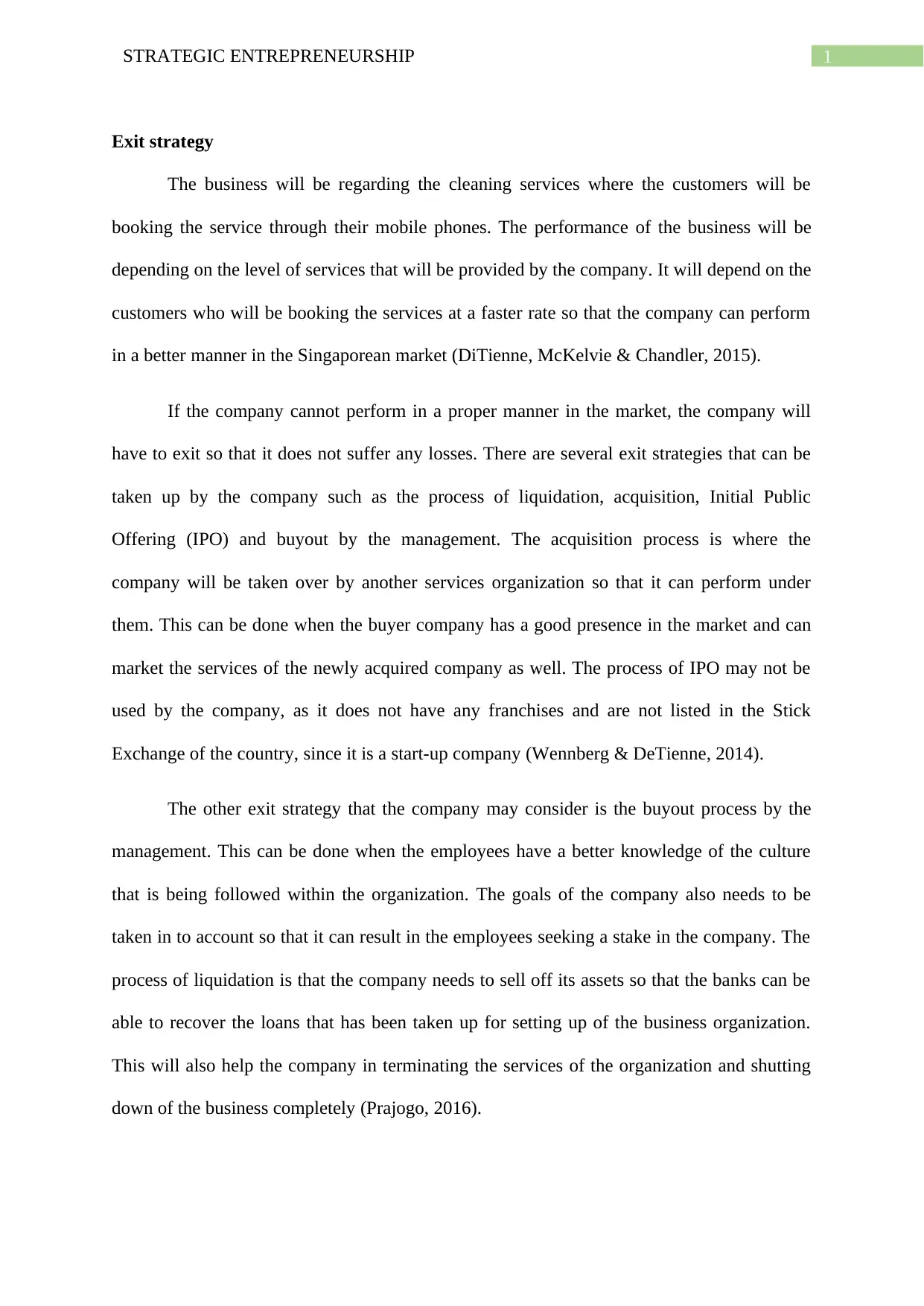
1STRATEGIC ENTREPRENEURSHIP
Exit strategy
The business will be regarding the cleaning services where the customers will be
booking the service through their mobile phones. The performance of the business will be
depending on the level of services that will be provided by the company. It will depend on the
customers who will be booking the services at a faster rate so that the company can perform
in a better manner in the Singaporean market (DiTienne, McKelvie & Chandler, 2015).
If the company cannot perform in a proper manner in the market, the company will
have to exit so that it does not suffer any losses. There are several exit strategies that can be
taken up by the company such as the process of liquidation, acquisition, Initial Public
Offering (IPO) and buyout by the management. The acquisition process is where the
company will be taken over by another services organization so that it can perform under
them. This can be done when the buyer company has a good presence in the market and can
market the services of the newly acquired company as well. The process of IPO may not be
used by the company, as it does not have any franchises and are not listed in the Stick
Exchange of the country, since it is a start-up company (Wennberg & DeTienne, 2014).
The other exit strategy that the company may consider is the buyout process by the
management. This can be done when the employees have a better knowledge of the culture
that is being followed within the organization. The goals of the company also needs to be
taken in to account so that it can result in the employees seeking a stake in the company. The
process of liquidation is that the company needs to sell off its assets so that the banks can be
able to recover the loans that has been taken up for setting up of the business organization.
This will also help the company in terminating the services of the organization and shutting
down of the business completely (Prajogo, 2016).
Exit strategy
The business will be regarding the cleaning services where the customers will be
booking the service through their mobile phones. The performance of the business will be
depending on the level of services that will be provided by the company. It will depend on the
customers who will be booking the services at a faster rate so that the company can perform
in a better manner in the Singaporean market (DiTienne, McKelvie & Chandler, 2015).
If the company cannot perform in a proper manner in the market, the company will
have to exit so that it does not suffer any losses. There are several exit strategies that can be
taken up by the company such as the process of liquidation, acquisition, Initial Public
Offering (IPO) and buyout by the management. The acquisition process is where the
company will be taken over by another services organization so that it can perform under
them. This can be done when the buyer company has a good presence in the market and can
market the services of the newly acquired company as well. The process of IPO may not be
used by the company, as it does not have any franchises and are not listed in the Stick
Exchange of the country, since it is a start-up company (Wennberg & DeTienne, 2014).
The other exit strategy that the company may consider is the buyout process by the
management. This can be done when the employees have a better knowledge of the culture
that is being followed within the organization. The goals of the company also needs to be
taken in to account so that it can result in the employees seeking a stake in the company. The
process of liquidation is that the company needs to sell off its assets so that the banks can be
able to recover the loans that has been taken up for setting up of the business organization.
This will also help the company in terminating the services of the organization and shutting
down of the business completely (Prajogo, 2016).
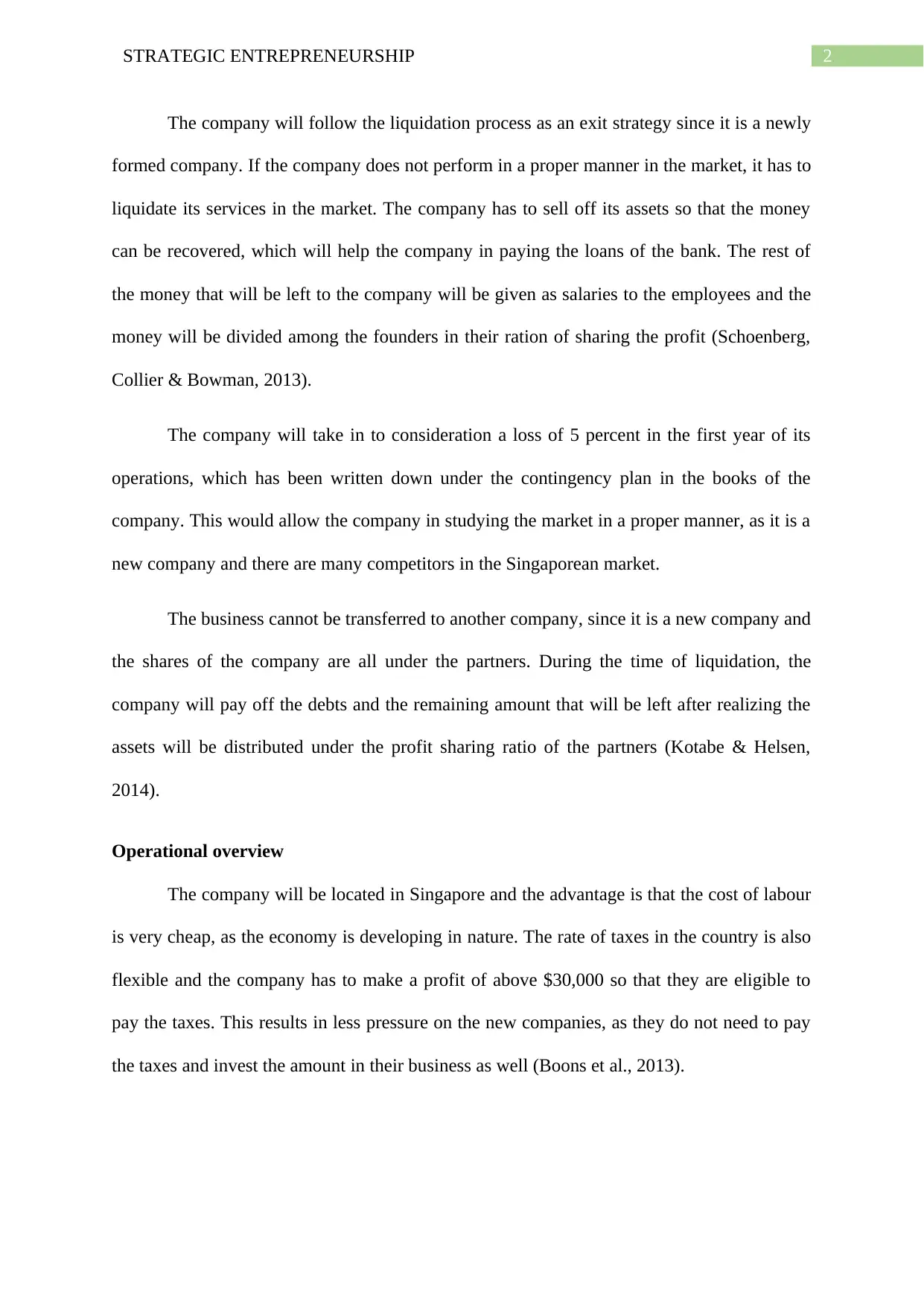
2STRATEGIC ENTREPRENEURSHIP
The company will follow the liquidation process as an exit strategy since it is a newly
formed company. If the company does not perform in a proper manner in the market, it has to
liquidate its services in the market. The company has to sell off its assets so that the money
can be recovered, which will help the company in paying the loans of the bank. The rest of
the money that will be left to the company will be given as salaries to the employees and the
money will be divided among the founders in their ration of sharing the profit (Schoenberg,
Collier & Bowman, 2013).
The company will take in to consideration a loss of 5 percent in the first year of its
operations, which has been written down under the contingency plan in the books of the
company. This would allow the company in studying the market in a proper manner, as it is a
new company and there are many competitors in the Singaporean market.
The business cannot be transferred to another company, since it is a new company and
the shares of the company are all under the partners. During the time of liquidation, the
company will pay off the debts and the remaining amount that will be left after realizing the
assets will be distributed under the profit sharing ratio of the partners (Kotabe & Helsen,
2014).
Operational overview
The company will be located in Singapore and the advantage is that the cost of labour
is very cheap, as the economy is developing in nature. The rate of taxes in the country is also
flexible and the company has to make a profit of above $30,000 so that they are eligible to
pay the taxes. This results in less pressure on the new companies, as they do not need to pay
the taxes and invest the amount in their business as well (Boons et al., 2013).
The company will follow the liquidation process as an exit strategy since it is a newly
formed company. If the company does not perform in a proper manner in the market, it has to
liquidate its services in the market. The company has to sell off its assets so that the money
can be recovered, which will help the company in paying the loans of the bank. The rest of
the money that will be left to the company will be given as salaries to the employees and the
money will be divided among the founders in their ration of sharing the profit (Schoenberg,
Collier & Bowman, 2013).
The company will take in to consideration a loss of 5 percent in the first year of its
operations, which has been written down under the contingency plan in the books of the
company. This would allow the company in studying the market in a proper manner, as it is a
new company and there are many competitors in the Singaporean market.
The business cannot be transferred to another company, since it is a new company and
the shares of the company are all under the partners. During the time of liquidation, the
company will pay off the debts and the remaining amount that will be left after realizing the
assets will be distributed under the profit sharing ratio of the partners (Kotabe & Helsen,
2014).
Operational overview
The company will be located in Singapore and the advantage is that the cost of labour
is very cheap, as the economy is developing in nature. The rate of taxes in the country is also
flexible and the company has to make a profit of above $30,000 so that they are eligible to
pay the taxes. This results in less pressure on the new companies, as they do not need to pay
the taxes and invest the amount in their business as well (Boons et al., 2013).
⊘ This is a preview!⊘
Do you want full access?
Subscribe today to unlock all pages.

Trusted by 1+ million students worldwide
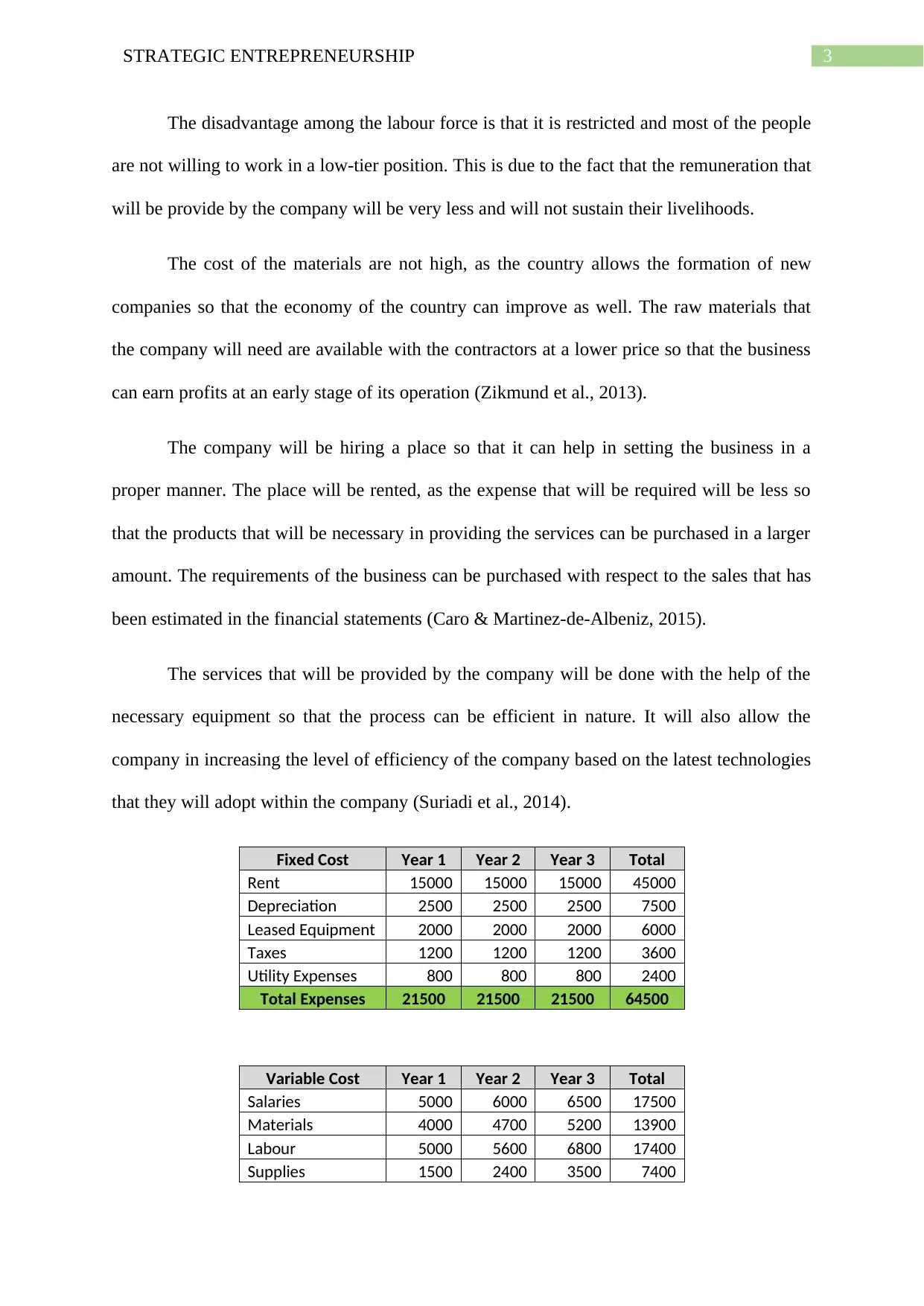
3STRATEGIC ENTREPRENEURSHIP
The disadvantage among the labour force is that it is restricted and most of the people
are not willing to work in a low-tier position. This is due to the fact that the remuneration that
will be provide by the company will be very less and will not sustain their livelihoods.
The cost of the materials are not high, as the country allows the formation of new
companies so that the economy of the country can improve as well. The raw materials that
the company will need are available with the contractors at a lower price so that the business
can earn profits at an early stage of its operation (Zikmund et al., 2013).
The company will be hiring a place so that it can help in setting the business in a
proper manner. The place will be rented, as the expense that will be required will be less so
that the products that will be necessary in providing the services can be purchased in a larger
amount. The requirements of the business can be purchased with respect to the sales that has
been estimated in the financial statements (Caro & Martinez-de-Albeniz, 2015).
The services that will be provided by the company will be done with the help of the
necessary equipment so that the process can be efficient in nature. It will also allow the
company in increasing the level of efficiency of the company based on the latest technologies
that they will adopt within the company (Suriadi et al., 2014).
Fixed Cost Year 1 Year 2 Year 3 Total
Rent 15000 15000 15000 45000
Depreciation 2500 2500 2500 7500
Leased Equipment 2000 2000 2000 6000
Taxes 1200 1200 1200 3600
Utility Expenses 800 800 800 2400
Total Expenses 21500 21500 21500 64500
Variable Cost Year 1 Year 2 Year 3 Total
Salaries 5000 6000 6500 17500
Materials 4000 4700 5200 13900
Labour 5000 5600 6800 17400
Supplies 1500 2400 3500 7400
The disadvantage among the labour force is that it is restricted and most of the people
are not willing to work in a low-tier position. This is due to the fact that the remuneration that
will be provide by the company will be very less and will not sustain their livelihoods.
The cost of the materials are not high, as the country allows the formation of new
companies so that the economy of the country can improve as well. The raw materials that
the company will need are available with the contractors at a lower price so that the business
can earn profits at an early stage of its operation (Zikmund et al., 2013).
The company will be hiring a place so that it can help in setting the business in a
proper manner. The place will be rented, as the expense that will be required will be less so
that the products that will be necessary in providing the services can be purchased in a larger
amount. The requirements of the business can be purchased with respect to the sales that has
been estimated in the financial statements (Caro & Martinez-de-Albeniz, 2015).
The services that will be provided by the company will be done with the help of the
necessary equipment so that the process can be efficient in nature. It will also allow the
company in increasing the level of efficiency of the company based on the latest technologies
that they will adopt within the company (Suriadi et al., 2014).
Fixed Cost Year 1 Year 2 Year 3 Total
Rent 15000 15000 15000 45000
Depreciation 2500 2500 2500 7500
Leased Equipment 2000 2000 2000 6000
Taxes 1200 1200 1200 3600
Utility Expenses 800 800 800 2400
Total Expenses 21500 21500 21500 64500
Variable Cost Year 1 Year 2 Year 3 Total
Salaries 5000 6000 6500 17500
Materials 4000 4700 5200 13900
Labour 5000 5600 6800 17400
Supplies 1500 2400 3500 7400
Paraphrase This Document
Need a fresh take? Get an instant paraphrase of this document with our AI Paraphraser
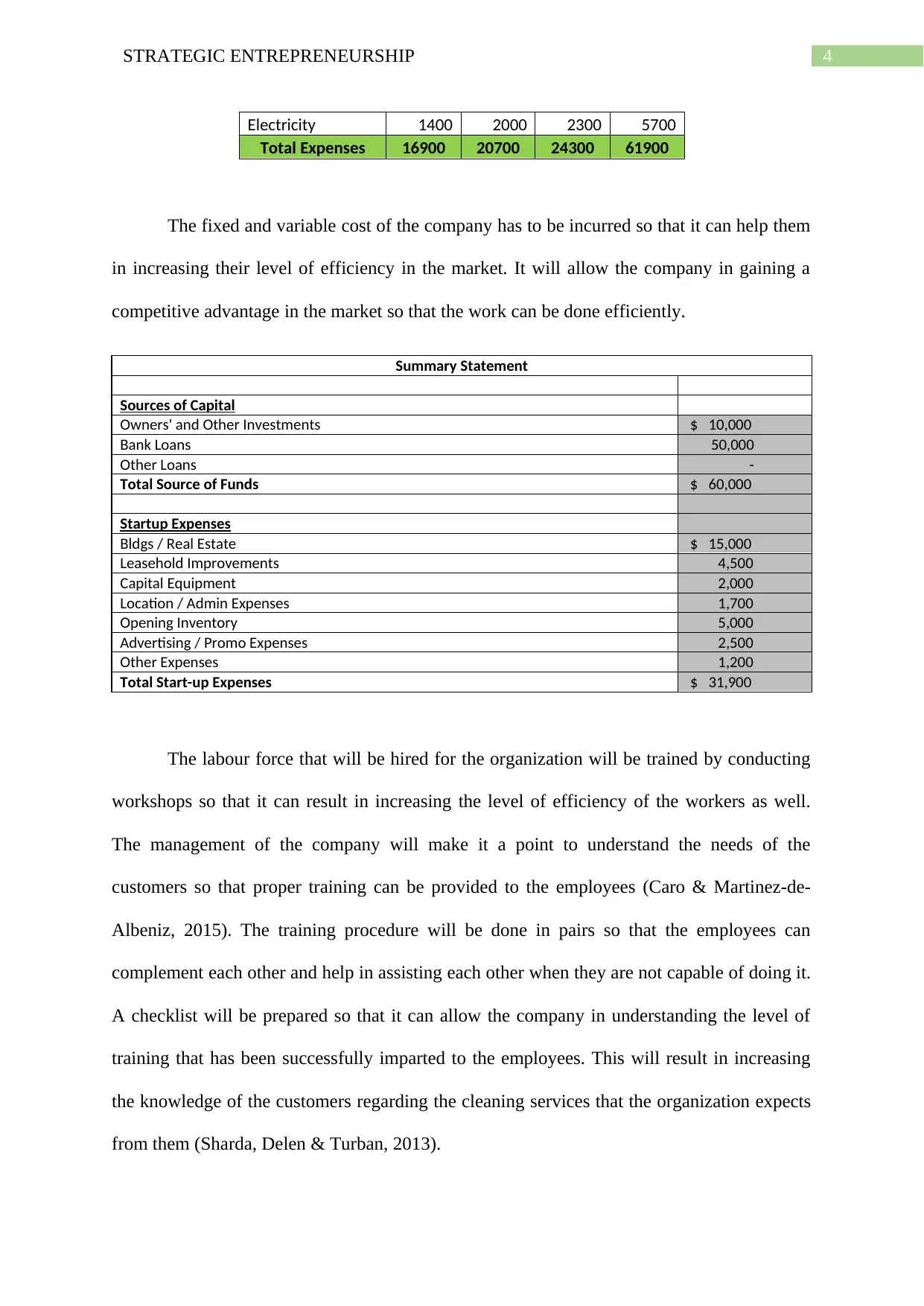
4STRATEGIC ENTREPRENEURSHIP
Electricity 1400 2000 2300 5700
Total Expenses 16900 20700 24300 61900
The fixed and variable cost of the company has to be incurred so that it can help them
in increasing their level of efficiency in the market. It will allow the company in gaining a
competitive advantage in the market so that the work can be done efficiently.
Summary Statement
Sources of Capital
Owners' and Other Investments $ 10,000
Bank Loans 50,000
Other Loans -
Total Source of Funds $ 60,000
Startup Expenses
Bldgs / Real Estate $ 15,000
Leasehold Improvements 4,500
Capital Equipment 2,000
Location / Admin Expenses 1,700
Opening Inventory 5,000
Advertising / Promo Expenses 2,500
Other Expenses 1,200
Total Start-up Expenses $ 31,900
The labour force that will be hired for the organization will be trained by conducting
workshops so that it can result in increasing the level of efficiency of the workers as well.
The management of the company will make it a point to understand the needs of the
customers so that proper training can be provided to the employees (Caro & Martinez-de-
Albeniz, 2015). The training procedure will be done in pairs so that the employees can
complement each other and help in assisting each other when they are not capable of doing it.
A checklist will be prepared so that it can allow the company in understanding the level of
training that has been successfully imparted to the employees. This will result in increasing
the knowledge of the customers regarding the cleaning services that the organization expects
from them (Sharda, Delen & Turban, 2013).
Electricity 1400 2000 2300 5700
Total Expenses 16900 20700 24300 61900
The fixed and variable cost of the company has to be incurred so that it can help them
in increasing their level of efficiency in the market. It will allow the company in gaining a
competitive advantage in the market so that the work can be done efficiently.
Summary Statement
Sources of Capital
Owners' and Other Investments $ 10,000
Bank Loans 50,000
Other Loans -
Total Source of Funds $ 60,000
Startup Expenses
Bldgs / Real Estate $ 15,000
Leasehold Improvements 4,500
Capital Equipment 2,000
Location / Admin Expenses 1,700
Opening Inventory 5,000
Advertising / Promo Expenses 2,500
Other Expenses 1,200
Total Start-up Expenses $ 31,900
The labour force that will be hired for the organization will be trained by conducting
workshops so that it can result in increasing the level of efficiency of the workers as well.
The management of the company will make it a point to understand the needs of the
customers so that proper training can be provided to the employees (Caro & Martinez-de-
Albeniz, 2015). The training procedure will be done in pairs so that the employees can
complement each other and help in assisting each other when they are not capable of doing it.
A checklist will be prepared so that it can allow the company in understanding the level of
training that has been successfully imparted to the employees. This will result in increasing
the knowledge of the customers regarding the cleaning services that the organization expects
from them (Sharda, Delen & Turban, 2013).
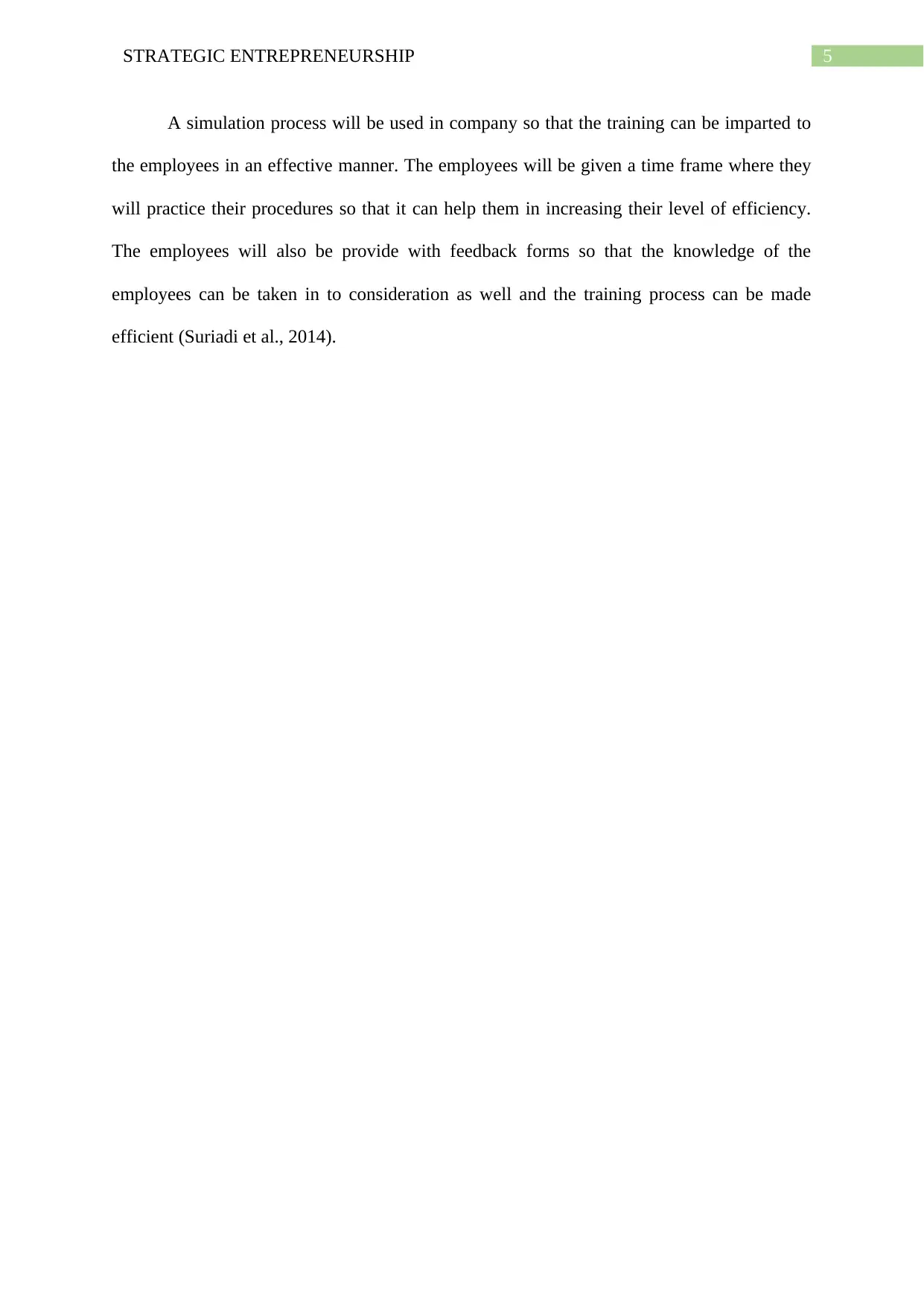
5STRATEGIC ENTREPRENEURSHIP
A simulation process will be used in company so that the training can be imparted to
the employees in an effective manner. The employees will be given a time frame where they
will practice their procedures so that it can help them in increasing their level of efficiency.
The employees will also be provide with feedback forms so that the knowledge of the
employees can be taken in to consideration as well and the training process can be made
efficient (Suriadi et al., 2014).
A simulation process will be used in company so that the training can be imparted to
the employees in an effective manner. The employees will be given a time frame where they
will practice their procedures so that it can help them in increasing their level of efficiency.
The employees will also be provide with feedback forms so that the knowledge of the
employees can be taken in to consideration as well and the training process can be made
efficient (Suriadi et al., 2014).
⊘ This is a preview!⊘
Do you want full access?
Subscribe today to unlock all pages.

Trusted by 1+ million students worldwide
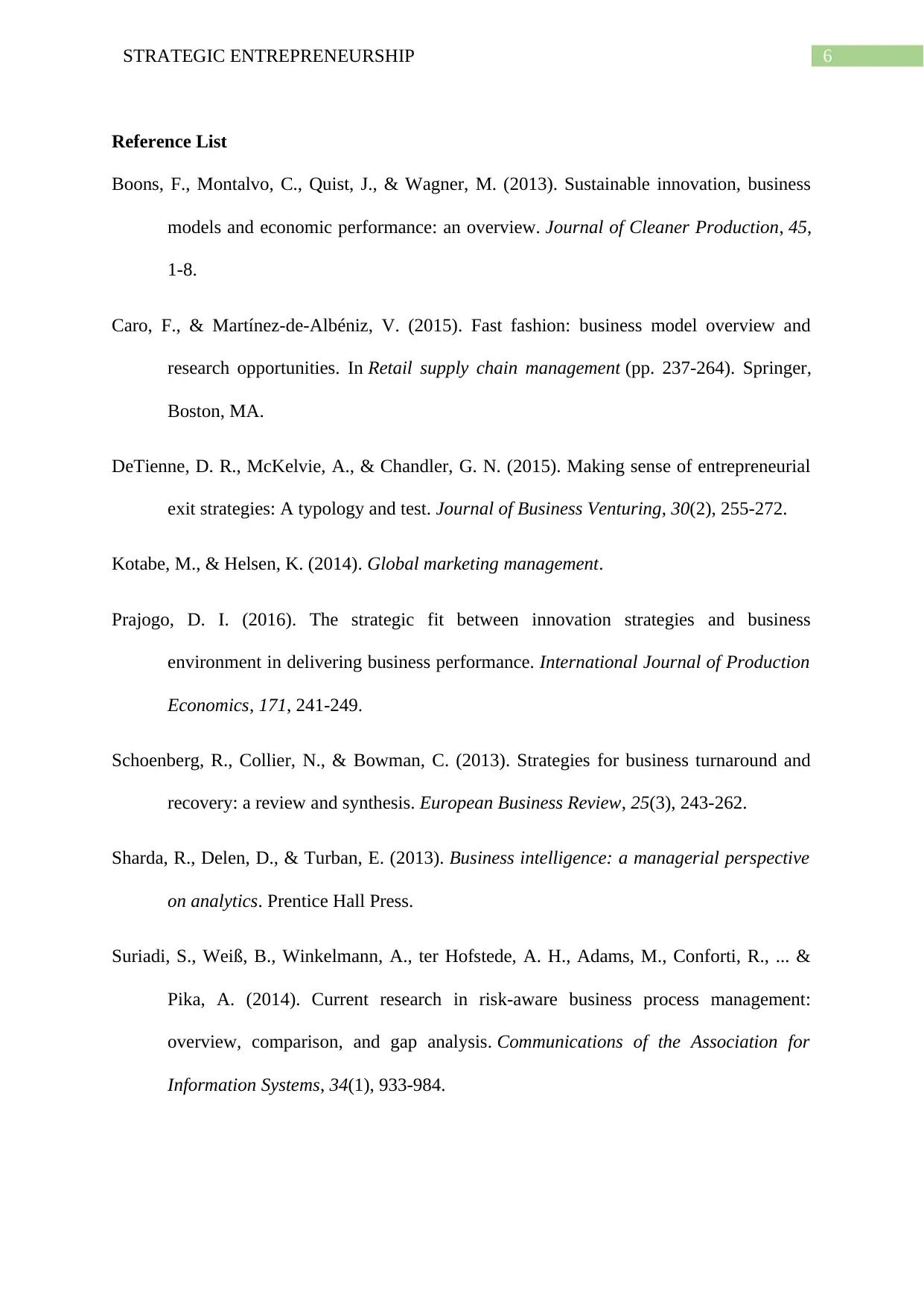
6STRATEGIC ENTREPRENEURSHIP
Reference List
Boons, F., Montalvo, C., Quist, J., & Wagner, M. (2013). Sustainable innovation, business
models and economic performance: an overview. Journal of Cleaner Production, 45,
1-8.
Caro, F., & Martínez-de-Albéniz, V. (2015). Fast fashion: business model overview and
research opportunities. In Retail supply chain management (pp. 237-264). Springer,
Boston, MA.
DeTienne, D. R., McKelvie, A., & Chandler, G. N. (2015). Making sense of entrepreneurial
exit strategies: A typology and test. Journal of Business Venturing, 30(2), 255-272.
Kotabe, M., & Helsen, K. (2014). Global marketing management.
Prajogo, D. I. (2016). The strategic fit between innovation strategies and business
environment in delivering business performance. International Journal of Production
Economics, 171, 241-249.
Schoenberg, R., Collier, N., & Bowman, C. (2013). Strategies for business turnaround and
recovery: a review and synthesis. European Business Review, 25(3), 243-262.
Sharda, R., Delen, D., & Turban, E. (2013). Business intelligence: a managerial perspective
on analytics. Prentice Hall Press.
Suriadi, S., Weiß, B., Winkelmann, A., ter Hofstede, A. H., Adams, M., Conforti, R., ... &
Pika, A. (2014). Current research in risk-aware business process management:
overview, comparison, and gap analysis. Communications of the Association for
Information Systems, 34(1), 933-984.
Reference List
Boons, F., Montalvo, C., Quist, J., & Wagner, M. (2013). Sustainable innovation, business
models and economic performance: an overview. Journal of Cleaner Production, 45,
1-8.
Caro, F., & Martínez-de-Albéniz, V. (2015). Fast fashion: business model overview and
research opportunities. In Retail supply chain management (pp. 237-264). Springer,
Boston, MA.
DeTienne, D. R., McKelvie, A., & Chandler, G. N. (2015). Making sense of entrepreneurial
exit strategies: A typology and test. Journal of Business Venturing, 30(2), 255-272.
Kotabe, M., & Helsen, K. (2014). Global marketing management.
Prajogo, D. I. (2016). The strategic fit between innovation strategies and business
environment in delivering business performance. International Journal of Production
Economics, 171, 241-249.
Schoenberg, R., Collier, N., & Bowman, C. (2013). Strategies for business turnaround and
recovery: a review and synthesis. European Business Review, 25(3), 243-262.
Sharda, R., Delen, D., & Turban, E. (2013). Business intelligence: a managerial perspective
on analytics. Prentice Hall Press.
Suriadi, S., Weiß, B., Winkelmann, A., ter Hofstede, A. H., Adams, M., Conforti, R., ... &
Pika, A. (2014). Current research in risk-aware business process management:
overview, comparison, and gap analysis. Communications of the Association for
Information Systems, 34(1), 933-984.
Paraphrase This Document
Need a fresh take? Get an instant paraphrase of this document with our AI Paraphraser
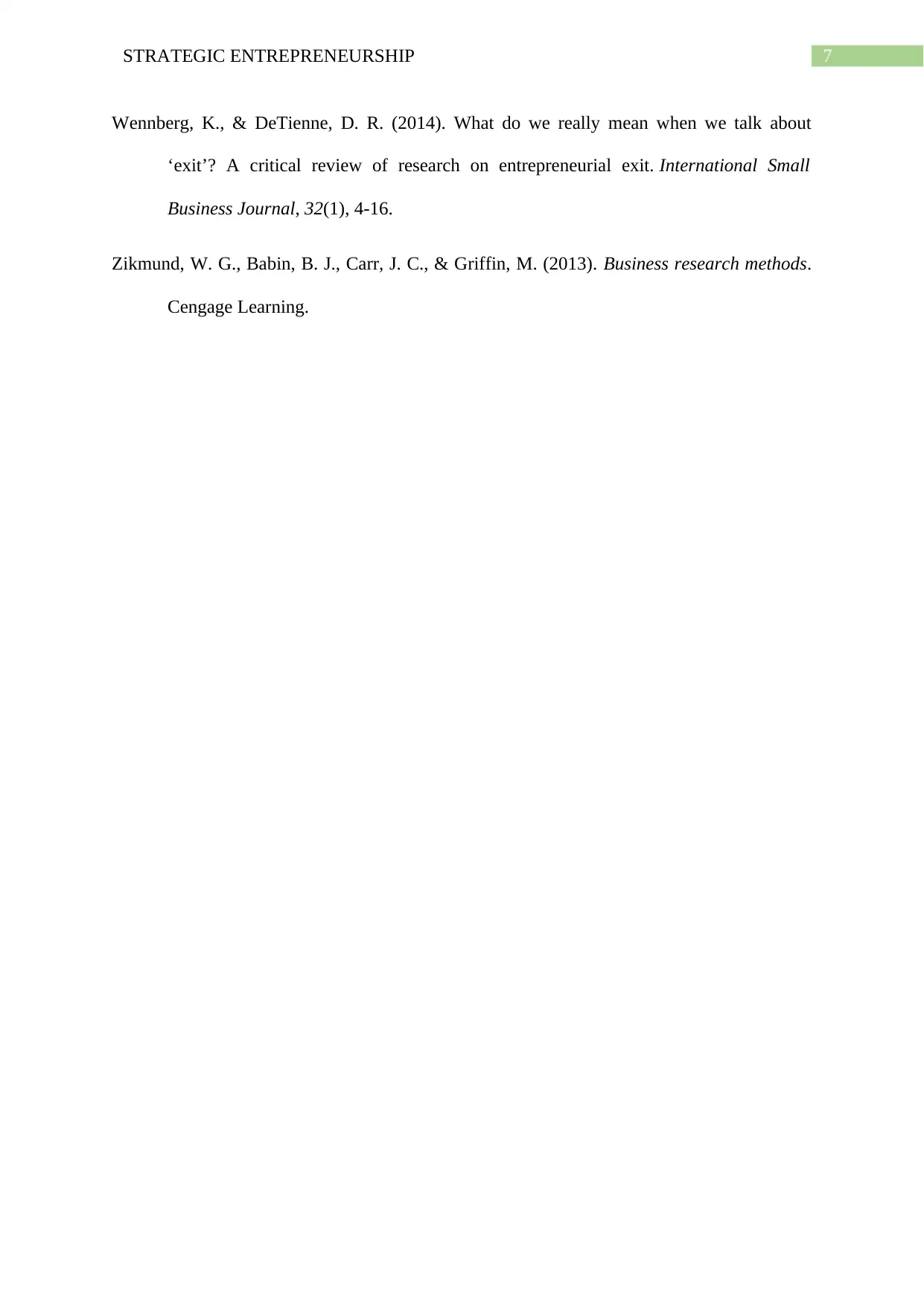
7STRATEGIC ENTREPRENEURSHIP
Wennberg, K., & DeTienne, D. R. (2014). What do we really mean when we talk about
‘exit’? A critical review of research on entrepreneurial exit. International Small
Business Journal, 32(1), 4-16.
Zikmund, W. G., Babin, B. J., Carr, J. C., & Griffin, M. (2013). Business research methods.
Cengage Learning.
Wennberg, K., & DeTienne, D. R. (2014). What do we really mean when we talk about
‘exit’? A critical review of research on entrepreneurial exit. International Small
Business Journal, 32(1), 4-16.
Zikmund, W. G., Babin, B. J., Carr, J. C., & Griffin, M. (2013). Business research methods.
Cengage Learning.
1 out of 8
Related Documents
Your All-in-One AI-Powered Toolkit for Academic Success.
+13062052269
info@desklib.com
Available 24*7 on WhatsApp / Email
![[object Object]](/_next/static/media/star-bottom.7253800d.svg)
Unlock your academic potential
Copyright © 2020–2025 A2Z Services. All Rights Reserved. Developed and managed by ZUCOL.





